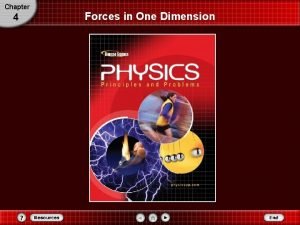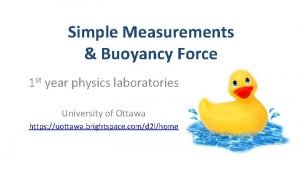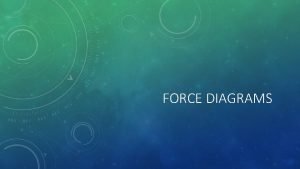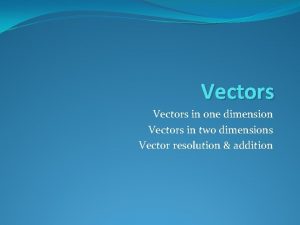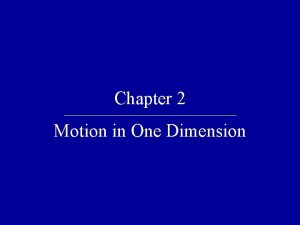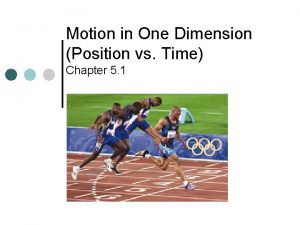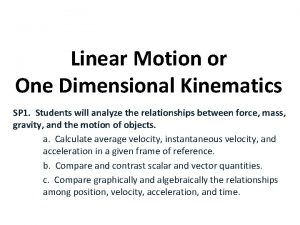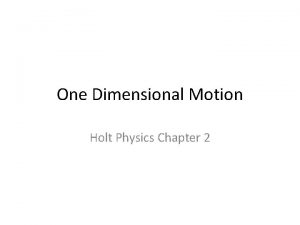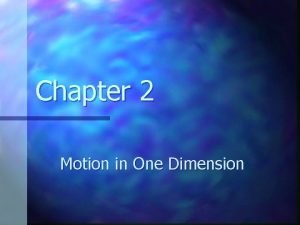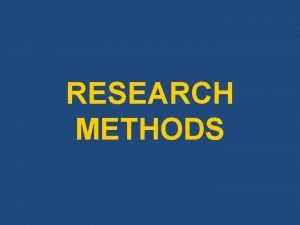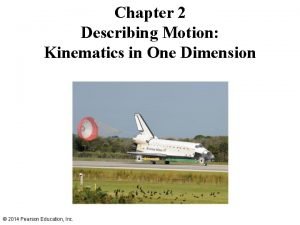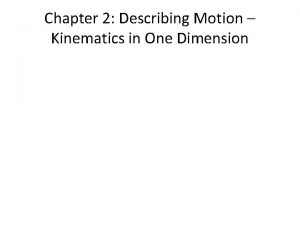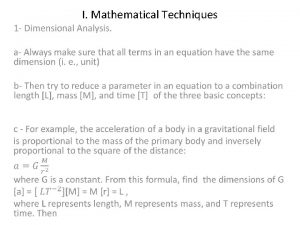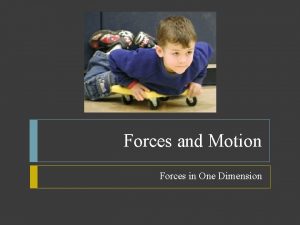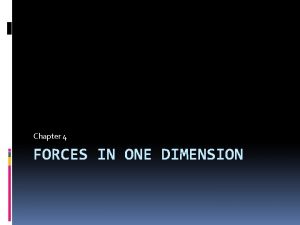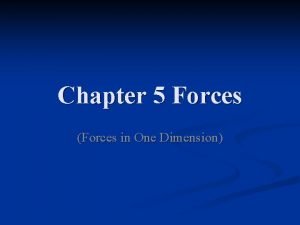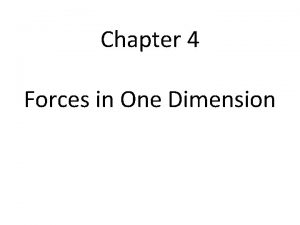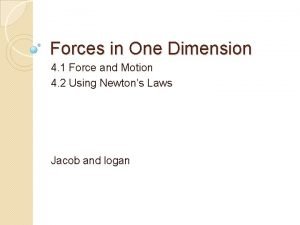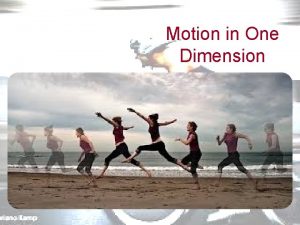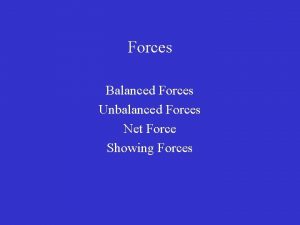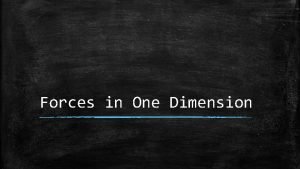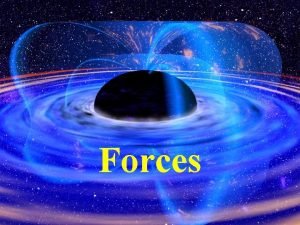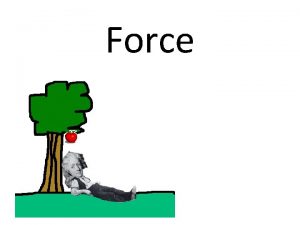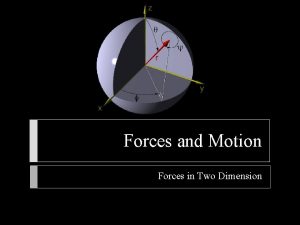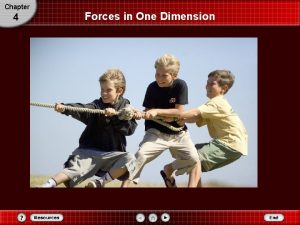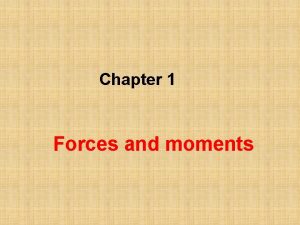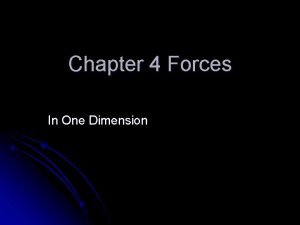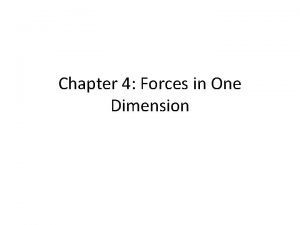Forces in One Dimension Chapter 4 Force and



































- Slides: 35

Forces in One Dimension Chapter 4

Force and Motion Lesson 1

Force • Force- a push or pull. • If you push or pull harder on an object, you exert a greater force on the object. • You increase the magnitude of the applied force. • The direction in which the force is exerted also matters. • If you push the resting book right, the book will start moving to the left, because forces have both magnitude and direction: forces are vectors • Force is measured in Newtons (N)

Unbalanced Forces • Unbalanced forces change motion • Recall that motion diagrams describe the positions of an object at equal time intervals. • All acceleration are the result of an unbalanced force acting on an object. • Example: The hand pushing on the book exerts a force that causes the book to accelerate in the direction of the unbalanced force.

Systems and External World • System- the object or objects of interest • When considering how a force affects motion, it is important to identify the object or objects called systems. • Everything around the system with which the system can interact is called The External World. • Example: The book is the system. Your hand, earth, string and the table are parts of the external world that interact with the book by pushing or pulling on it.

Contact Force • A contact force exists when an object from the external world touches a system, exerting a force on it. • Example: You could push or pull it by directly touching it, or you could tie a string around it and pull on the string. • If you are holding a text book in your hands you are exerting a contact force.

Field Forces • Field Forces are exerted without contact. • Example: If you drop a book and as it falls to the ground, the gravitational force of Earth acting on the book causes this acceleration. This force affects the book whether or not Earth is actually touching it. • Gravitation force is an example of Field Force.

Agents • Agent- forces result from interactions; every contact and field force has specific and identifiable cause. • You should be able to name the agent exerting each force as well as the system upon which the force is exerted. • Example: when you push your textbook, your hand (the agent) exerts a force on the text book.

Free-Body Diagrams • Free-Body Diagram- is a physical representation that shows the force acting on a system. • Follow this guidelines when drawing a free-body system: • The free body is drawn separately from the sketch of the problem situation. • Apply the particle model, and represent the object with a dot • Represent each force with an arrow that points in the direction • make the length of each arrow

Continued • Label each force • Choose a direction

Combining Forces • When you push together in the same direction, you give the table twice the acceleration that it would have if just one of you applied 100 N of force. • When you push on the table in the opposite direction with the same amount of force, there is no unbalanced force, so the table does not accelerate but remains at rest. • Refer to page 93 for an example.

Net Force • Net Force-another term for the vector sum of all the forces on an object. • When the force vectors are in the same direction, they can be replaced by one vector with a length equal to their combined length. • When the forces are in opposite directions, the resultant is the length of the difference between the two vectors.

Out/Questions • Gravitational Force is in what category?

Acceleration and Force • Apply Constant Force- One way is to use a device called a spring scale. • Inside the scale is a spring that stretches proportionally to the magnitude of the applied force.

Newton’s Second Law on Motion • States that the acceleration of an object is proportional to the net force and inversely proportional to the mass of the object being accelerated. • This law is based on observations of how forces affect masses and is represented by the following equation. • A=Fnet m

Solving Problems using Newton’s Second Law • One of the most important steps in correctly applying Newton’s Second Law is determining the net force acting on the object. • Often more than one force acts on an object, so you must add the force vectors to determine the net force. • Once the net force is determined use Newton’s Second Law of Motion to calculate the acceleration.

Newton’s First Law of Motion • In the absence of a net force, the velocity of the moving ball and the lack of motion of the stationary object do not change. • Newton recognized this and generalized Galileo’s results into a single statement. • An object that is a rest will remain at rest, and an object that is moving will continue to move in a straight line with constant speed, if and only if the net force acting on that object is zero.

Inertia • Newton’s First Law is sometimes called the Law of Inertia. • Inertia-is the tendency of an object to resist changes in velocity. • Refer to page 98 figure 8 • Inertia is not a force (forces are results of interactions between two objects)

Equilibrium • According to Newton’s First Law, a net force causes the velocity of an object to change. • If the net force on an object is zero, then the object is in equilibrium.

Questions/Out • Newton’s First Law of Motion is also called?

Weight and Drag Force Lesson 2

Weight • Weight-Is the gravitational force experienced by that object. • Gravitational force is a field force. • Equation form: Fg=mg • The mass of the object is m, and g, called the gravitational field is a vector quantity that relates the mass of an object to the gravitational force it experiences at a given time.

Apparent Weight • Apparent weight- the support force exerted on an object. • Weightlessness- does not mean that an object’s weight is actually zero; rather, it means that there are no contact forces acting to support the object and the objects apparent weight is zero.

Drag Force • Drag Force- is the force exerted by a fluid on an object opposing motion through the fluid. • This force is dependent on the motion of the object, the properties of the object, and the properties of the fluid that the object is moving through.

Terminal Velocity • The constant velocity that is reached when the drag force equals the force of gravity.

Questions/Out • How do force and mass affect acceleration?

Newton’s Third Law Lesson 3

Interaction Pairs • Interaction pairs-is a set of two forces that are in opposite directions, have equal magnitudes, and act on different objects. • Sometimes called an action-reaction pair • You may see the system equation written as FA on B and FB on A

Newton’s Third Law • Newton’s Third Law- States that all forces come in pairs. • Is an interaction pair • Newton’s Third Law Equation: FA on B = -FB on A

Using Newton’s Third Law • Refer to page 107 • For steps on solving problems

Tension • Tension-is simply a specific name for the force that a string or rope exerts. • A simplification assume that all strings and ropes are massless.

Normal Force • Normal Force- is the perpendicular contact force that a surface exerts on another surface. • Is always perpendicular to the plane of contact between two objects. • But is always equal to the weight of an object. • FN=Fg-FA on B

Questions/Out • What is Normal Force?

Newton’s Third Law Math Review

Newton’s Third Law • Insure you have a book. • We will start on page 108
 Forces in one dimension
Forces in one dimension Chapter 4 forces in one dimension
Chapter 4 forces in one dimension Chapter 2 motion in one dimension answer key
Chapter 2 motion in one dimension answer key Example of like parallel forces and unlike parallel forces
Example of like parallel forces and unlike parallel forces What is contact force
What is contact force Balanced forces and unbalanced forces venn diagram
Balanced forces and unbalanced forces venn diagram Are canyons constructive or destructive
Are canyons constructive or destructive Dimension of buoyant force
Dimension of buoyant force Willow cabin speech
Willow cabin speech Force diagrams and component forces
Force diagrams and component forces The forces shown above are pushing/pulling forces
The forces shown above are pushing/pulling forces Intramolecular forces vs intermolecular forces
Intramolecular forces vs intermolecular forces Intermolecular forces in a lava lamp
Intermolecular forces in a lava lamp Intramolecular forces vs intermolecular forces
Intramolecular forces vs intermolecular forces Vectors in one dimension
Vectors in one dimension Motion in one dimension quiz
Motion in one dimension quiz To describe a position in more than one dimension
To describe a position in more than one dimension Tape charts and motion graphs
Tape charts and motion graphs The sears tower in chicago is 443 m tall. suppose a book
The sears tower in chicago is 443 m tall. suppose a book Free fall motion in one dimension
Free fall motion in one dimension A point has:
A point has: Dimensions of research design
Dimensions of research design Motion in one dimension
Motion in one dimension Describing motion kinematics in one dimension
Describing motion kinematics in one dimension Describing motion kinematics in one dimension
Describing motion kinematics in one dimension 2d motion equations
2d motion equations Motion in one dimension
Motion in one dimension One god one empire one emperor
One god one empire one emperor Little dog run
Little dog run One king one law one faith
One king one law one faith Byzantine definition
Byzantine definition One team one plan one goal
One team one plan one goal See one do one teach one
See one do one teach one One price policy
One price policy See one do one teach one
See one do one teach one One vision one identity one community
One vision one identity one community

